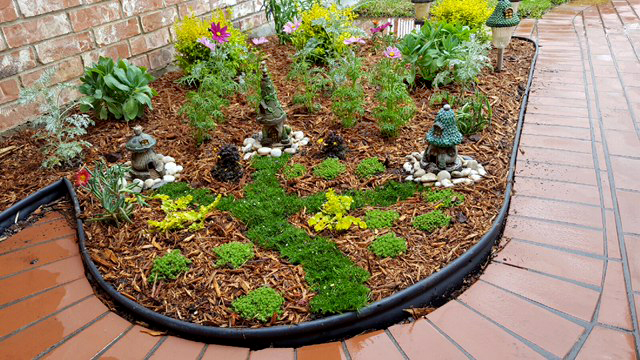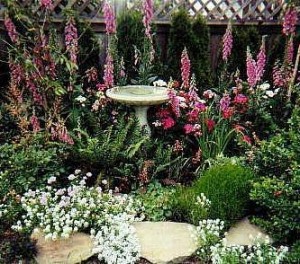Here I’ll talk about framing, softening the edges, creating paths and maximizing your patio’s potential.
The main purpose of a patio or terrace is to have a place to relax and entertain. Surrounding yourself with the beauty of plants will make it that much easier. Even non-gardeners now consider their patios an extension of their homes – a room without walls. Rather than just providing a view, interior design is carried from the inside out.
Framing
Creating a distinction between your patio or terrace and your lawn is how you turn this outdoor space into an outdoor room. You can accomplish this by outlining the patio with a border, by building raised planters around the edge or by creating an edge with containers.
Borders
Having a border around your terrace is enjoying the best of both worlds. You have a true garden to putter in and you never have to leave the comfort of your living area. The border will probably be somewhat narrow, 2-4 feet, but a lot can be accomplished in this space. In addition to plants that spill onto the patio, like a lady’s mantle and geraniums, you can create clusters of height with grasses or small shrubs. If the border runs between the house and the patio, you might want to try your hand at espalier or growing a fruit tree trained to lay flat against the house wall. The heat of the house and the openness of the branches produce a considerable yield in a small space.
Built-ins: Many patio designs have built-in flower boxes along the perimeter. They delineate the space and provide additional seating. But more importantly, they provide an eye level garden. You have all the advantages and control of container gardening as well as the root insulation provided by brick or stone. Many plants will do well in these circumstances, but it’s especially nice to have scented plants: roses, heliotrope, gardenias, jasmine, and sweet peas.
Containers
If you don’t have an edge border or built-in boxes, you can always create the effect with containers. Either an entire row of matched containers, simulating built-ins, or clusters of different sizes and shapes, filled with a variety of plant material.
Any of these options will create a distinction between your living space and the openness of the rest of your property.
Softening Hard Edges
Stone is beautiful, but on its own, it can look cold, hard and uninviting. Two types of plants will be especially useful in turning your patio or terrace into a welcoming retreat.
Spillers
Plants that flow out onto the stone will automatically soften the hard edges. Light, airy foliage is especially good for this. Lady’s mantle (Alchemila mollis), Love-In-A-Mist (Nigella damascena), coreopsis, lavender, and ferns are good examples. Just be sure to suit your plants to your sun exposure, because proximity to stone is going to intensify the heat.
Creepers
Unless your patio or terrace is paved, there are bound to be spaces between your stones. You’ll learn soon enough that weeds will readily grow there. So why not use the spaces to grow something more attractive? Thyme, sedum, scotch moss, and creeping jenny are often used for this purpose. Don’t try to fill every crack. Plants can become slippery when squished or wet and you should use care that heavy traffic areas are safe. But a few selected spots will give your terrace a touch of Tuscany and a well lived in feel. You’ll be surprised how quickly these plants will acclimate and find their own way around the patio.
Creating Seating Areas and Privacy Sitting Areas
The major point about using plants around sitting areas is to be sure you leave enough space to get to them. You’ll want at least 3 feet on every side of a table, to get into your chairs. And use some judgment when choosing plants. Consider their rate of growth and their mature size. Some plants can be trimmed back, but small trees get larger and plants with thorns should be kept away from seating areas and paths.
Privacy & Creating Height
Privacy on your patio or terrace can easily be accomplished with well-situated raised planters and containers, as discussed above. You should also consider creating some height in your plantings.
Vines & Climbers
A trellis or latticework used as open fencing makes an ideal spot for a climber or vine.
Clematis, trumpet vine, honeysuckle, morning glories, even cucumbers can be used to create an open wall that allows a passage but not prying eyes.
If your terrace is too sunny or warm, you also might want to consider some sort of pergola across at least part of it, which gives you one more place to plant. Climbing hydrangea, Jasmine, Magnolias, Camellias, and Wisteria are good examples.
Planting on a patio or terrace can be an end to a means, a garden for enjoyment and not toiling, or it can be a work of art that’s within reach. Linking your home and yard with a patio garden can really be the best of small space gardening because it will allow your garden to suit your gardening aspirations. Until next time…Happy Gardening!!!

